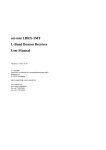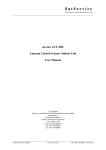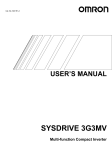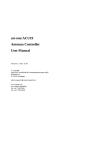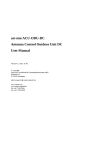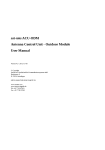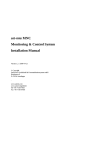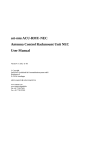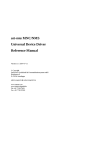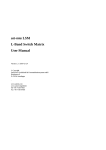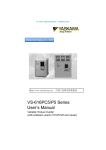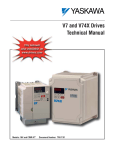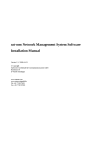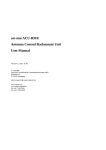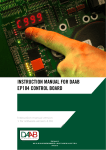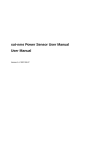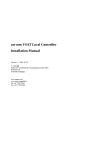Download ACS3000 Upgrade Kit
Transcript
SatService Gesellschaft für Kommunikationssysteme mbH Installation and user manual sat-nms ACU-ACS ACS3000 Upgrade Kit © Copyright SatService Gesellschaft für Kommunikatiosnsysteme mbH Hardstrasse 9 D-78256 Steisslingen E-Mail: [email protected] www.satnms.com www.satservicegmbh.de Tel +49 7738 97003 Fax +49 7738 97005 © 2015, SatService GmbH www.satnms.com ACU_ACS-UM-1502-1.doc page 1/28 SatService Gesellschaft für Kommunikationssysteme mbH 1 Table Of Contents 1 2 3 4 5 6 7 Table Of Contents .............................................................................................................. 2 Safety instructions .............................................................................................................. 4 The sat-nms ACU-ACS ...................................................................................................... 5 3.1 sat-nms ACU-ODM ................................................................................................... 6 3.2 Optional sat-nms L-Band beacon receiver ................................................................. 6 3.3 Optional Ethernet switch ............................................................................................ 6 3.4 Power supplies............................................................................................................ 7 3.5 Relays ......................................................................................................................... 7 3.5.1 Solid state relays..................................................................................................... 7 3.5.2 Electromagnetic relay ............................................................................................. 7 Installation of sat-nms ACU-ACS into the existing cabinet .............................................. 8 4.1 Collecting data of the existing controller ................................................................... 9 4.2 Removing the mains cable and the cables to the antenna .......................................... 9 4.3 Removing the existing, not longer needed parts ........................................................ 9 4.3.1 Removing the motor cables .................................................................................... 9 4.3.2 Disassembly of the circuit-breaker-unit ............................................................... 11 4.4 Integrating the circuit-breaker-unit into the sat-nms ACU-ACS ............................. 13 4.5 Mechanical installation of the sat-nms ACU-ACS .................................................. 14 4.6 Electrical integration of the sat-nms ACU-ACS ...................................................... 14 4.7 Re-connection of the external components .............................................................. 16 start-up .............................................................................................................................. 17 5.1 Start up the retrofitted antenna controller ................................................................ 17 5.2 Frequency inverter.................................................................................................... 19 5.2.1 Changing the parameters to the desired control parameters ................................ 19 5.2.2 Optimizing the frequency inverter’s parameters: ................................................. 19 5.3 Starting up the tracking system ................................................................................ 19 Specifications ................................................................................................................... 21 Appendix .......................................................................................................................... 22 7.1 list of cable labels ..................................................................................................... 22 7.2 list of terminal assignment ....................................................................................... 23 7.3 schematics ................................................................................................................ 24 7.4 drawings ................................................................................................................... 28 © 2015, SatService GmbH www.satnms.com ACU_ACS-UM-1502-1.doc page 2/28 SatService Gesellschaft für Kommunikationssysteme mbH Revision History: Date action responsible 26.02.2010 created Simon Zimmermann 02.02.2015 shematics update Simon Zimmermann © 2015, SatService GmbH www.satnms.com ACU_ACS-UM-1502-1.doc page 3/28 SatService Gesellschaft für Kommunikationssysteme mbH 2 Safety instructions SAFETY The mains shall only be connected provided with a protective earth wire. Any interruption of the protective wire, inside or outside the sat-nms ACU-ACS, is likely to make the unit dangerous. Intentional interruption is prohibited. The unit described in this manual is designed to be used by properly-trained personnel only. Adjustment, maintenance and repair of the exposed equipment shall be carried out only by qualified personnel who are aware of hazards involved. Refer servicing to qualified personnel. To prevent electrical shock, do not remove covers. For the correct and safe use of the instrument, it is essential that both operating and servicing personnel follow generally accepted safety procedures in addition to the safety precautions specified in this manual. Whenever it is likely that safety protection is impaired, the unit must be made in-operative and secured against unintended operation. The appropriate servicing authority must be informed. For example, safety is likely to be impaired if the unit fails to perform the intended measurements or shows visible damage. Ensure that the cabinet is proper connected to the protective earth conductor. The circuit breaker, that fuses the mains for the sat-nms ACU-ACS has to switch off the 3 phases together. WARNINGS The outside of the equipment may be cleaned using a lightly dampened cloth. Do not use any cleaning liquids containing alcohol, methylated spirit or ammonia etc. Follow standard Electrostatic Discharge (ESD) procedures when handling the unit. Apply the appropriate voltage according to the attached schematic. In case of switching off all the circuit breakers or the mains switch, it is still voltage available at the mains terminals! Only use shielded cable to connect the AZ- and EL-Motor. The other components in the cabinet might be jammed through the harmonic waves the frequency inverters inject into the motor wires. Keep the unshielded part to connect the motor- and resolver-cables as short as possible to avoid disturbance trouble. Use only double shielded twisted pair cables (e.g. CAT6 Ethernet cable) to connect the resolvers to the sat-nms ACU-ACS © 2015, SatService GmbH www.satnms.com ACU_ACS-UM-1502-1.doc page 4/28 SatService Gesellschaft für Kommunikationssysteme mbH 3 The sat-nms ACU-ACS The sat-nms ACU-ACS is an upgrade kit for existing ASC Signal (formerly Andrew) ACS3000 antenna controllers. The controller and its periphery is replaced by state-of-the-art components, the other components like frequency inverters, transformer or circuit breakers will be kept. The electronics of the sat-nms ACU-ACS are mounted to an adapter-plate that has to be installed to the existing cabinet. As it is pre-wired the installation could be done without problems by personal with electronically knowledge. 7 1 8 2 8 3 4 9 5 10 6 11 12 The sat-nms ACU-ODU consist of the following main units: (1) sat-nms ACU-ODM (2) Optional sat-nms LBRX beacon receiver (8) cabling to emergency stop (3) Optional Ethernet switch (9) space for existing circuit breakers (4) power supplies (10) terminals for resolvers (5) relays (11.) terminal for AZ- EL- and POL-motor (6) terminals for limit switches (12.) cabling to central PE-point © 2015, SatService GmbH (7) www.satnms.com cabling to existing components ACU_ACS-UM-1502-1.doc page 5/28 SatService Gesellschaft für Kommunikationssysteme mbH The following chapters describe all of the units and how to handle them. The main part of this documentation gives a detailed description how to integrate the sat-nms ACU-ACS into the existing cabinet and how to use the new system. 3.1 sat-nms ACU-ODM The sat-nms ACU-ODM is the central controller of the sat-nms ACU-ODU. For the detailed operation of the antenna controller please refer to the documentation of the sat-nms ACUODM, which is an extra document. In this document you find also the description how to change the IP address of the unit in order to integrate the antenna controller in your sub-net. A short version of the documentation could also be found on the internal website of the satnms ACU-ODM. Just enter the IP-address of the unit (standard-IP is: 192.168.2.69) into the Web-browser of a connected computer and press the ‘HELP’ button on the left side. 3.2 Optional sat-nms L-Band beacon receiver It is possible to realize a complete antenna tracking system with the sat-nms ACU-ODU. For this it is possible to integrate an the sat-nms L-Band beacon receiver (‘LBRX’) into the sat-nms ACU-ACS. In this case it is necessary to integrate the optional Ethernet switch into the sat-nms ACU-ACS. As the level information is in this case transferred via Ethernet (by UDP packets) between the beacon receiver and the antenna step track system the sat-nms LBRX beacon receiver not necessarily has to be at the same place as the antenna controller. It can be at a completely different location , the only requirement is that it is connected to the same Ethernet. Please refer to the documentation of the sat-nms LBRX how to setup the parameters of this unit and how to connect it. A short version of the documentation could be found on the internal website of the sat-nms LBRX. Just enter the IP-address of the unit (standard-IP is: 192.168.2.65) into the Webbrowser of a connected computer and press the ‘HELP’ button on the left side 3.3 Optional Ethernet switch The sat-nms ACU-ACS can be equipped with an optional Ethernet switch. By this way it is easy to connect a notebook for troubleshooting or make some parameter changes. It is also possible to integrate an optional sat-nms L-Band beacon receiver. So you can upgrade the sat-nms ACU-ODU to a complete antenna tracking system. For this option the optional Ethernet switch is necessary. © 2015, SatService GmbH www.satnms.com ACU_ACS-UM-1502-1.doc page 6/28 SatService Gesellschaft für Kommunikationssysteme mbH 3.4 Power supplies The Power supplies step down the internal 115VAC of the existing cabinet to 24VDC, that is necessary for the units used at sat-nms ACU-ACS. The schematics shows which power supply provides voltage to which unit. 3.5 Relays There are 2 different types of relays used: 3.5.1 Solid state relays These relays are used to switch power, like in this case the POL-Motor. The advance is the zero-point switching, that causes nearly no switching disturbance. It is only possible to switch AC-signals with the used relays. Because of this reason, we also used: 3.5.2 Electromagnetic relay This relay is used to double the emergency-stop signal. Another relay is to break the power supplies for the POL-motor in case of an emergency-stop. © 2015, SatService GmbH www.satnms.com ACU_ACS-UM-1502-1.doc page 7/28 SatService Gesellschaft für Kommunikationssysteme mbH 4 Installation of sat-nms ACU-ACS into the existing cabinet This chapter gives a detailed overview how to implement the sat-nms ACU-ACS into your existing ACS3000 controller cabinet. Until now, your existing ACS3000 cabinet should look as you can see on the following picture. © 2015, SatService GmbH www.satnms.com ACU_ACS-UM-1502-1.doc page 8/28 SatService Gesellschaft für Kommunikationssysteme mbH 4.1 Collecting data of the existing controller the first step is collect all necessary data from the existing controller. When you have this parameters the start-up of the new controller will be a lot easier. How to get the needed values, is described in the documentation of the ACS3000 controller. soft-limit values: AZ CW: EL hi: POL CW: AZ CCW: EL lo: POL CCW: EL: POL: actual antenna position: AZ: After collecting this data, do not move the antenna anymore with the old controller or by hand until the new controller is connected! 4.2 Removing the mains cable and the cables to the antenna All the screws that are disassembled have to be kept until the retrofit is done. You will need some of them again to fix the new components! IMPORTANT!!! the very first step is to switch off the mains voltage after this, remove all the cables that are connected to the terminals of the ACS3000 controller. Attention, Do not forget to label the cables before disconnecting! In the attachment you can find a list, which signal is connected to the terminals. The mains cable can be left connected. Assure, that the mains power is switched off during retrofit. 4.3 Removing the existing, not longer needed parts it is the easiest way, if you follow the step-by step instruction in the given order. 4.3.1 Removing the motor cables Disconnect the orange motor cables on the terminals. Open the Frequency inverter’s connection Box: 1) Remove the cover where the type is printed on (1 screw) 2) Remove the plastic cover (2 clips on the left and right) 3) Remove the metal cover (1 screw) Open the screws on all terminals and disconnect the cables on the frequency-inverter output and remove them. Disconnect the orange cables at the circuit breakers © 2015, SatService GmbH www.satnms.com ACU_ACS-UM-1502-1.doc page 9/28 SatService Gesellschaft für Kommunikationssysteme mbH Open the screws that fix the cable-tray. Do not throw the screws away, you will need them again later. Raise the cable tray and disconnect the cables at the line-filter of the frequency inverters. Now you can remove the cables and the tray as well. Remove the distance bolts the tray was fixed to The following picture shows all the mentioned parts: solid state relays 115V Transformer Frequency inverter AZ Frequency inverter EL motor overload switch emergency-stop-switch power supply power interface board CPU-board ACU-interface unit memory interface board terminals cable for remote controller Remove the Plexiglas cover from the CPU-Board (4screws) Disconnect all cables at the CPU-board, the memory interface board, the power interface board, the ACU-interface unit and the emergency-stop-switch Disconnect the cables at the terminals and take them out of the cabinet Disconnect the controller cables (gray coated) from the frequency inverters and remove them Pull the 3 cards out of the ACU-interface-unit (2 screws per card) Disassemble the ACU-interface unit (4 screws), the CPU-board (4 screws and 4 distance-bolts), the memory interface (2 screws) and the power interface board (4 screws) © 2015, SatService GmbH www.satnms.com ACU_ACS-UM-1502-1.doc page 10/28 SatService Gesellschaft für Kommunikationssysteme mbH Disconnect the cables at the power supply and disassemble this part (3 screws) Disconnect the cables at the solid state relays, remove them and disassemble the solid state relays (2relays, 2 screws per relay) Remove the cables at the 115V transformer, excepting the PE-cable Remove the cables at the motor overload switch Cut off the cable for the remote controller Disassemble the DIN rail with all the terminals 4.3.2 Disassembly of the circuit-breaker-unit The circuit breakers and the contactors are re-used in the new system. Nevertheless they have to be disassembled in the following way: Keep all the cables between contactor output and circuit breaker input Disconnect the mains cables at the contactor, keep them connected at the mains switch! Disconnect all cables at the outlet of the circuit breakers and the contactor Disconnect the control cables of the contactors ATTENTION! It is essentially that you keep the R-C combination at the control inputs at K1, otherwise the solid-state relay that controls the contactors will be damaged! After disassembling, the circuit-breaker-unit, it should look like this: © 2015, SatService GmbH www.satnms.com ACU_ACS-UM-1502-1.doc page 11/28 SatService Gesellschaft für Kommunikationssysteme mbH after removing all cables, the cabinet should look as you can see on the following picture.As you can see, the fixing points for the cable ties do not have to be removed. © 2015, SatService GmbH www.satnms.com ACU_ACS-UM-1502-1.doc page 12/28 SatService Gesellschaft für Kommunikationssysteme mbH 4.4 Integrating the circuit-breaker-unit into the sat-nms ACU-ACS Clip the circuit-breakers and the contactors to the DIN-rail next to the relays. Connect all the cables to the circuit breakers and the contactors. All the cables are labeled, so it will be easy for you to find the destination of each cable. Pay attention, that the R-C-combination is connected correct and properly to the control-inputs (A1 and A2) of K1 After integrating the circuit-breaker-unit, the sat-nms ACU-ACS, should look like this: © 2015, SatService GmbH www.satnms.com ACU_ACS-UM-1502-1.doc page 13/28 SatService Gesellschaft für Kommunikationssysteme mbH 4.5 Mechanical installation of the sat-nms ACU-ACS The sat-nms ACU-ACS has to be fixed with 6 of the existing screws at the backplane of the cabinet. The three holes at the bottom of the sat-nms ACU-ACS match with the threads, the old terminal-rail was fixed to. The three holes on the top, match with one of the threads the old power supply was fixed to and two other treads that could formerly be used for optional equipment Put the sat-nms ACU-ACS into the existing cabinet and fix the screws properly. Take care, that no cable is crushed between the backplane of the cabinet and the backing structure of the sat-nms ACU-ACS. The PE-cable of the LAN-connector has to be fixed with the screw bottom left as you can see on the following picture: 4.6 Electrical integration of the sat-nms ACU-ACS ATTENTION! Electrical installation shall be carried out only by qualified personnel who are instructed and aware of hazards of electrical shocks All of the cables, that have to be connected to existing components are labeled. In the attachment of this documentation you can find a list with all labels vs. the destination and origin part. The labels are mentioned in the schematics as well. Connect the PE from the sat-nms ACU-ACS ground-plate to the central PE-point as shown on the following picture: © 2015, SatService GmbH www.satnms.com ACU_ACS-UM-1502-1.doc page 14/28 SatService Gesellschaft für Kommunikationssysteme mbH Connect the control cables (at A1 and A2) at K1 and K2. ensure that the R-C combination is fixed properly as shown on the schematics. Connect the mains cables coming from the mains power switch to the contactor-inputs as shown on the schematics Connect the long black cables to the heater terminals Connect the motor cables to the frequency inverters, first to the AZ- then to the ELinverter. Ensure that the shield of the cable is connected properly to the PE-point of the frequency inverter Fix the Motor cables and the heater cables with cable ties to the existing mounting parts Connect the control cables to the frequency inverters. Ensure that the shield is connected properly to the according PE-point of the frequency inverter. Fix the control cables with one cable tie to the according motor cable cable tie shield of motor cable shield of controller cable Connect the cables to the 115V transformer Connect the cables to the motor overload switch Connect the cables to the emergency stop switch Connect the cables to the line filters of the frequency inverters Fix all the cables with cable ties to the existing fixing parts © 2015, SatService GmbH www.satnms.com ACU_ACS-UM-1502-1.doc page 15/28 SatService Gesellschaft für Kommunikationssysteme mbH After connecting all of the cables from the sat-nms ACU-ACS to the existing components, the cabinet should look like this: 4.7 Re-connection of the external components After installing the sat-nms ACU-ACS into the existing cabinet , all the cables of the external components have to be connected to the terminals of the sat-nms ACU-ACS as shown on the schematics. © 2015, SatService GmbH www.satnms.com ACU_ACS-UM-1502-1.doc page 16/28 SatService Gesellschaft für Kommunikationssysteme mbH 5 start-up 5.1 Start up the retrofitted antenna controller Follow the following step-by-step instruction to ensure a correct startup without problems. Every point that causes an action contains everything that has to happen after this action. If something more happens or something does not happen, fix this problem before you go to the next step! Ensure, that all circuit breakers are switched off Push the emergency-stop-switch (the contact at the switch is open now) Switch on the mains switch switch on F4 o 115V are available between pin X1 and X3 at the 115V transformer o PS1 and PS2 have to run now (the green LED is on) o The sat-nms ACU-ODM, the Ethernet switch and the optional sat-nms LBRX (if available) are running and reachable via Ethernet. The IP addresses in delivery-state are: sat-nms ACU-ODM: 192.168.2.69, sat-nms LBRX: 192.168.2.65 Set the IP-Addresses of the sat-nms ACU-ODM and (if available) the sat-nms LBRX to the desired values. How to do this is described in the manuals of these units: Enter the website of the sat-nms ACU-ODM, press the ‘STOP’-Button bottom left: Check the function and the correlation of all limit-switches manually. On the sat-nms ACU-ODM’s website every single limit switch is displayed (see Manual of the satnms ACU-ODM) Set the software-limits to the values that you have collected from the old ACS3000 Antenna controller. If you do not have these values, set the software limits to the appreciated values. The precise setting of these values is the next to last step of the startup. Write down the actual position displayed by the ACU AZ: EL: POL: Check the rotational direction of the resolvers. If necessary, invert the rotational direction. (see Manual of the sat-nms ACU-ODM). You can check the rotational direction in two ways: o You move the antenna by a hand crank. If the resolver direction is wrong, first move the antenna back to the original position (see the values above) then invert the rotational direction and try it again. © 2015, SatService GmbH www.satnms.com ACU_ACS-UM-1502-1.doc page 17/28 SatService Gesellschaft für Kommunikationssysteme mbH o You loosen the mechanical connection between the antenna and the resolver and turn it manually. After ensuring the correct rotation direction, properly fix the resolver at the antenna again Set the offsets of the resolvers to the desired values (see Manual of the sat-nms ACUODM) Check, if the sat-nms ACU-ODM is still ‘stopped’ to ensure that no motor movement will occur with switching on their mains Switch on the emergency-stop-switch o K3 and K8 switch to ‘on’-state o K4 switches to ‘on’-state, green LED is on o K1 and K2 switch to ‘on’-state o On the ACU-ODM’s website the ‘Emergeny stop’ indication disappears Switch on F1, the AZ-frequency inverter has to run now Switch on F2, the EL frequency inverter has to run now Set the control-Parameters of the frequency inverters to the desired new values. How to do this is written in the following chapter “5.2 Frequency inverter”. If you use the controller for another antenna the controller was original mounted to, you have to change the motor parameters and perhaps some settings concerning Hi/Lo speed limits etc. In this case we refer to the manual of the frequency inverter. Check the motor rotating directions of AZ and EL driver, if necessary change it by interchanging 2 phase-wires of the motor cable, or invert parameter n040 in the frequency inverter. Check the rotating direction of the POL-Motor. If necessary change the cables on TB1 terminal #7 and #8 to reverse the direction Drive the antenna in every direction (AZ, EL and POL) until the limit switches stop the motor movement to ensure that the limit switches work well. ATTENTION! While doing this test it is absolutely necessary to be very mindful to check, if nothing collides! Write down the values of the hardware-limits: AZ CW: EL hi: POL CW: AZ CCW: EL lo: POL CCW: If you do not want to keep the old values (or if you do not have them anyway), set the soft-limits to the desired values (e.g. 1° before the hardware limit switch is activated) Check the heater by spraying some cooling spray at the temperature sensor. It is a little orange or red unit located top left above the frequency inverter. © 2015, SatService GmbH www.satnms.com ACU_ACS-UM-1502-1.doc page 18/28 SatService Gesellschaft für Kommunikationssysteme mbH 5.2 Frequency inverter The frequency inverter is the “high power interface” between the ACU and the motors. As they already are optimized for your antenna, you only have to change some control parameters. If you use the retrofitted ACS3000 for another antenna, you might have to change the motor parameters as well. In this case refer to the manual of the frequency inverters. 5.2.1 Changing the parameters to the desired control parameters To access a parameter, press the DSPL button several times until the PRGM LED is on. Use the UP and DOWN keys to select the desired parameter. Press ENTER to access the parameter. Use the UP and DOWN keys to adjust the value. After that press ENTER to safe the parameter. Then press DSPL to leave the parameter section. Just follow the step-by-step instruction below: set parameter n001=2 (access level to the desired values) check the value of parameter n011 and write it down: n011=______ (max. frequency) set parameter n018=0 (time unit for ramp times) set parameter n019=1* (ramp up time) set parameter n020=0.3* (ramp down time) set parameter n025 to 20% of the value of parameter n011* (low speed frequency) set parameter n026=n011 (high speed frequency) set parameter n056=11 (define input S7 as ramp select input, enable n019 and n020) set parameter n057=13 (define output as ready-state output) * this value is an empirical value. It is in the most cases ok, perhaps you have to adjust this parameter, see the following chapter. 5.2.2 Optimizing the frequency inverter’s parameters: You may optimize the ramp up- and down time in case of occurring faults at the frequency inverter. Setting parameter n056=10 disables the parameters n019 and n020 completely. In this case the internal ramps of the frequency inverter are used. If the antenna does not move reliable in low speed mode, increase the low speed frequency at parameter n025. If the antenna has some problems with exact pointing (overshooting the desired angle) you might decrease value n025. 5.3 Starting up the tracking system If you have the additional sat-nms LBRX it is now time to startup the tracking system. We only give a very small overview about the startup-procedure of the tracking. the more detailed description could be found in the documentation of the sat-nms LBRX and the satnms ACU-ODM. © 2015, SatService GmbH www.satnms.com ACU_ACS-UM-1502-1.doc page 19/28 SatService Gesellschaft für Kommunikationssysteme mbH Please consider that both units have to be connected to the same LAN Subnet. Drive the antenna to the desired position Connect the L-Band signal to the L-Band input connector of the sat-nms LBRX. Configure the sat-nms LBRX to the desired values (please check sat-nms LBRX documentation) Configure the following parameters to the setup-site of the sat-nms LBRX: o UDP destination address: Type in the IP address of the sat-nms ACU-ODM o Configure the LO-frequencies. If you only have connected a LNC with one LO type this LO to be Low and the High band parameter. o Attention! after this, you have to select the “real” beacon-frequency, not the L-Band frequency that comes out of the LNC. Configure the following parameters to the sat-nms ACU-ODM: o Beacon RX-type: select “SATNMS” o Beacon RX address: type in the IP of the sat-nms LBRX o Beacon RX frequency: the “real” Beacon frequency, NOT the L-Band Frequency! Set the tracking parameters to the desired values (please check sat-nms ACU-ODM documentation) Select the desired tracking type (please check sat-nms ACU-ODM documentation) Start the tracking © 2015, SatService GmbH www.satnms.com ACU_ACS-UM-1502-1.doc page 20/28 SatService Gesellschaft für Kommunikationssysteme mbH 6 Specifications The table below summarizes the sat-nms ACU-ACS’s specifications: M&C Interface Specification Ethernet interface for M&C 10-Base-T, Via HTTP GET requests and user interface RS232 M&C Interface mini combicon 8pol (ACU-ODM), Dsub9 (optional LBRX) Electrical and Mechanical Specification, Environmental conditions Supply voltage 3x230V rotating current 50Hz (Motors) Ambient temperature range -20°C…+35°C, this value is only valid, when the sat-nms ACU-ACS is integrated into an old ACS3000 cabinet with heater. +5…+40°C not condensing, sat-nms ACU-ACS not integrated into a cabinet Dimensions (LxWxH) 500x400x160 mm (without optional LBRX) 500x400x190 mm (with optional LBRX) Weight © 2015, SatService GmbH approx. 14,5kg, about 0,5kg less without optional LBRX www.satnms.com ACU_ACS-UM-1502-1.doc page 21/28 SatService Gesellschaft für Kommunikationssysteme mbH 7 Appendix 7.1 list of cable labels the following list shows the cable labels and the referring parts that have to be connected lable F1 2 F1 4 F1 6 L1 AZ L2 AZ L3 AZ AZ EL F3 2 F3 4 1 5 F4 2 F4 4 H1 H5 colour black black black black black black shielded cable shielded cable black black black black black black black black X1 blue X3 brown 1 3 5 2 4 6 K1 A1 K1 A2 blue brown brown blue brown brown brown blue K2 A1 brown K2 A2 blue AZ control EL control Emer red stop red © 2015, SatService GmbH destination part F1 F1 F1 Line filter AZ Line filter AZ Line filter AZ Frequency inverter AZ Frequency inverter EL Heater terminal Heater terminal F3 F3 115V transformer 115V transformer F4 F4 PS1+PS2 F5 K2 PS1+PS2 F5 F5 F5 F5 F5 F5 F5 K1 K1 K1 K4 K1 115V transformer Frequency inverter AZ Frequency inverter EL Emergency stop switch pin 2 4 6 L1 L2 L3 T1, T2, T3, PE T1, T2, T3, PE 1 5 2 4 H1 H5 2 4 N 1 A2 L 3 1 3 5 2 4 6 A1 A2 A1 2 A2 X1 control inputs control inputs 1 2 www.satnms.com origin part Line filter AZ Line filter AZ Line filter AZ F1 F1 F1 terminal TB1 terminal TB1 F3 F3 Heater terminal Heater terminal F4 F4 115V transformer 115V transformer pin L1 L2 L3 2 4 6 1, 2, 3, PE 4, 5, 6, PE 2 4 1 5 2 4 H1 H5 115V transformer X1 115V transformer X3 K8 K8 F5 terminal TB1 F5 K5, K6, K7 K2 K2 K2 K2 K2 K2 ACU-ODM ACU-ODM K3, K8 PS2 24 14 4 9 5 2 A1 A1 A1 A1 A2 A2 CON11+CON13 CON10+CON11 A1 + ACU_ACS-UM-1502-1.doc page 22/28 SatService Gesellschaft für Kommunikationssysteme mbH 7.2 list of terminal assignment TB1 terminal Number 1 2 3 PE 4 5 6 PE 7 8 9 10 PE signal L1 L2 L3 PE L1 L2 L3 PE CW CCW COM Brake PE Unit AZ Driver EL Driver POL Driver TB2 terminal Number 1 2 3 4 5 6 7 8 9 10 11 12 13 14 15 16 17 18 19 20 21 22 23 24 25 26 27 28 29 30 31 32 33 34 35 signal CW COM CCW UP COM DOWN n.c. n.c. CW COM CCW n.c. n.c. n.c. GND REF GND SIN GND COS GND GND REF GND SIN GND COS GND GND REF GND SIN GND COS GND © 2015, SatService GmbH Unit AZ Limit switch EL Limit switch POL limit switch Azimuth resolver Elevation resolver Polarisation resolver www.satnms.com ACU_ACS-UM-1502-1.doc page 23/28 SatService Gesellschaft für Kommunikationssysteme mbH 7.3 schematics The units with gray background already exist in the cabinet. All the other ones are located on the sat-nms ACU-ACS plate © 2015, SatService GmbH www.satnms.com ACU_ACS-UM-1502-1.doc page 24/28 SatService Gesellschaft für Kommunikationssysteme mbH © 2015, SatService GmbH www.satnms.com ACU_ACS-UM-1502-1.doc page 25/28 SatService Gesellschaft für Kommunikationssysteme mbH © 2015, SatService GmbH www.satnms.com ACU_ACS-UM-1502-1.doc page 26/28 SatService Gesellschaft für Kommunikationssysteme mbH © 2015, SatService GmbH www.satnms.com ACU_ACS-UM-1502-1.doc page 27/28 SatService Gesellschaft für Kommunikationssysteme mbH 7.4 drawings © 2015, SatService GmbH www.satnms.com ACU_ACS-UM-1502-1.doc page 28/28




























